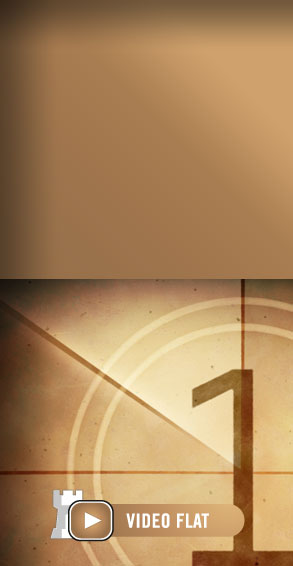Most Amazing Moves

In his greeting words at the start, Simon says cheerfully: ‘It was a lot of fun for me doing this DVD’. I am sure it would be as much fun for the audience, who would look through the amazing chess moves presented in this video. Five and a half hour of uninterrupted fun!
No chess player, beginner or more advanced, can remain unmoved when seeing the magic of human mind at work on the chess board. And dreaming … why, I could play that myself! That is how easy and obvious these moves appear – once revealed. But that is how unfathomable the apparent simplicity and geniality of the human mind is.
After savouring these chess brilliancies you are bound to be inspired, your bravery flared, and your outlook emboldened, so that you would approach the chess board next time with mind flexed to produce your own masterpiece. Well, dreaming can be productive.
This is a DVD to be kept at your side at all times. Running through it at one go would be wonderful mind gymnastics coupled with artistic beauty, but its usefulness does not stop there. One should return to it time and again. In good as well as at bad times. It would always provide mental respite and awake new optimism. Yes, it would be that beneficial! At least to those who hold that winning a game is not the only object: what brings a real sense of achievement and satisfaction is winning it as beautifully as possible.
Williams tells us further: ‘I enjoy looking at brilliant moves in chess more than I enjoy other artistic pursuits like looking at Mona Lisa or maybe listening to some lovely classical music…’ In other words, he is letting us know that chess is his favourite form of art. And in the video, this statement is given full credentials. The chosen examples cannot be found by the tactical prowess of computers but are product of human, mental creativity.

Simon Williams at the ChessBase recording studios
We are never tired of re-playing the games known as ‘evergreens’ or ‘immortal’ that include Paul Morphy v Count Isouard & Duke of Brunswick (Paris, 1858) and Anderssen v Kieseritzky (London, 1851). The title ‘Most Amazing Moves’ somehow alludes to the ‘chess romanticism’ when human mind was unaided by the dullness of computer’s precision, and the brilliancies were exactly that – a product of a brilliant mind. You would probably expect to see in this DVD a collection of similar fits from the glorified golden age of chess of the past. However, the two games mentioned above are not included, and, with a couple of exceptions, the examples demonstrated belong firmly in the ‘present’. Williams wants to assure us that brilliancies are not proper only to the ‘old romantics’, but they are real in our days too, played by real people at Championships as well as Opens around the world. The selected examples are his personal choice of amazing moves that have impressed him throughout his rich chess activity: Ivanchuk, Topalov, Short, Anand, Kortschnoj, Nimzowitsch and Fischer as well as some less illustrious names are among the executors of the brilliancies presented in the two parts of the video, Analysed Games and Extra Database. Naturally, Williams gives us some of his own brilliancies, performed at various tournaments, which are result of his uncompromising, attacking style.
The first analysed game is a 12-move miniature in which seemingly natural moves open the path to a most amazing combination:
Kantorik,Marian (2331) - Walton,Alan J (2153) [D31]
Gibraltar Masters 11th Caleta (5), 26.01.2013
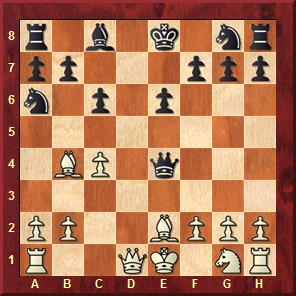
White to play: can you find the truly amazing move...
The answer is 9.Bf8!! Ne7 10.Bxg7 Rg8 11.Bf6 Qxg2 12.Qd6 1-0.
To give due credit to two probably best recognised chess artists, Anderssen and Morphy, here are two games from the DVD’s database selection: Anderssen v Dufresne (Berlin, 1852) Bird v Morphy (London, 1858).
The Anderssen v Dufresne game, known as ‘evergreen’, is annotated by Kasparov who comments towards the end: ‘It is not surprising that chess players of the time, impressed by such greatness, did not want to listen to dull positional advice. But the old combinational school, led by its first knight Andersen, was doomed in the battle against the modernized warfare techniques of Paul Morphy, whose tactics had much better positional foundations.’
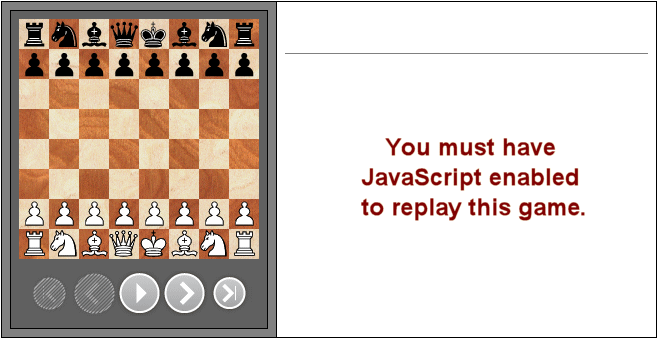
[Event "Berlin 'Evergreen'"] [Site "Berlin"] [Date "1852.??.??"] [Round "?"] [White "Anderssen, Adolf"] [Black "Dufresne, Jean"] [Result "1-0"] [ECO "C52"] [Annotator "Kasparov"] [PlyCount "47"] [EventDate "1852.??.??"] [EventType "game"] [EventRounds "1"] [EventCountry "GER"] [Source "ChessBase"] [SourceDate "1997.08.01"] {Today we will look at a game that bewitched its contemporaries and became known as the "evergreen".} 1. e4 e5 2. Nf3 Nc6 3. Bc4 Bc5 4. b4 Bxb4 5. c3 Ba5 6. d4 exd4 7. O-O d3 8. Qb3 Qf6 9. e5 Qg6 10. Re1 Nge7 11. Ba3 b5 12. Qxb5 Rb8 13. Qa4 Bb6 14. Nbd2 Bb7 15. Ne4 Qf5 16. Bxd3 Qh5 {[#] White has a huge advantage and it is time for decisive action. In accordance with his own romantic style and public demand Anderssen played} 17. Nf6+ {?!! The two exclamation marks are for one of the most beautiful combinations in chess history, which was started with this move. But objectively the search for beauty created unnecessary complications. The prosaic} (17. Ng3 Qh6 18. Bc1 Qe6 19. Bc4 Nd5 (19... Qg6 20. Nh4 Qg4 21. Bxf7+) 20. Ng5 Qg4 21. Re4 {would finish the game without any troubles, but then chess would have lost one of the jewels from its crown!}) 17... gxf6 18. exf6 Rg8 $1 {At first sight an open g-file gives Black excellent counter-attacking chances, but Anderssen's calculations were beyond the fears of an ordinary human being.} 19. Rad1 $1 {I'll spare you hundreds of analyses by following generations of chess players. After endless debate they have agreed that 19. Rad1 was better than the alternative 19.Be4. Now the best reply was 19...Rg4!, which would pose some difficult problems for White, but in the emerging wild complications White would, in my opinion, retain the upper hand.} Qxf3 $2 {Now White's king is suddenly just one step from decapitation. But how can we reproach Dufresne from not recognising the magic of a genius? [#]} 20. Rxe7+ $1 Nxe7 $5 {Another proof that chess masterpieces require the generous cooperation of the loser! Nowadays a professional player and, of course, a computer, would have without hesitation resorted to} (20... Kd8 {preventing the upcoming demolition, but losing anyway later after} 21. Rxd7+ $1 Kc8 (21... Kxd7 22. Bf5+ Ke8 23. Bd7+ Kd8 24. Bxc6+ {with mate}) 22. Rd8+ $1 Kxd8 (22... Rxd8 23. gxf3 {or}) (22... Nxd8 23. Qd7+ $3 {- the same motif}) 23. Be2+ {less clear is} ({weniger klar ist} 23. Bf5+ Qxd1+ 24. Qxd1+ Nd4 25. g3 Rg5 $1 26. Bh3 Bf3 $1) 23... Nd4 24. Bxf3 Bxf3 25. g3 Bxd1 26. Qxd1 {with a boring but winning endgame.}) 21. Qxd7+ $3 Kxd7 22. Bf5+ Ke8 23. Bd7+ Kf8 24. Bxe7# {It was not surprising that chess players of the time, impressed by this kind of greatness, did not want to listen to dull positional advice. But the old combinational school, led by its first knight Anderssen, was doomed in the battle against the modernized warfare techniques of Paul Morphy, whose tactics had much better positional foundations.} 1-0
The second example, Bird v Morphy (London, 1858), is the game which impressed Williams at an early age: ‘I was a junior when I first saw Morphy's next move, it shocked me to the core. Such craziness, yet such beauty! … Morphy’s brilliant concept and one which has stuck with me forever.’’

[Event "London m5"] [Site "London"] [Date "1858.??.??"] [Round "?"] [White "Bird, Henry Edward"] [Black "Morphy, Paul"] [Result "0-1"] [ECO "C41"] [Annotator "Williams,Simon"] [PlyCount "58"] [EventDate "1858.??.??"] [EventType "match"] [EventRounds "3"] [EventCountry "ENG"] [Source "ChessBase"] [SourceDate "1999.07.01"] 1. e4 e5 2. Nf3 d6 3. d4 f5 4. Nc3 fxe4 5. Nxe4 d5 (5... Nf6 6. Nxf6+ gxf6 ( 6... Qxf6 7. Bg5 $10) 7. dxe5 fxe5 8. Bc4 Qf6 9. Ng5 $16) 6. Ng3 (6. Nxe5 $1 dxe4 7. Qh5+ g6 8. Nxg6 Nf6 9. Qe5+ Kf7 10. Bc4+ Kg7 (10... Kxg6 11. Qg5#) 11. Bh6+ Kxh6 12. Nxh8 Bb4+ 13. c3 Qxh8 14. cxb4 $16) 6... e4 7. Ne5 Nf6 8. Bg5 (8. f3 $16) 8... Bd6 9. Nh5 O-O 10. Qd2 Qe8 11. g4 Nxg4 12. Nxg4 Qxh5 13. Ne5 Nc6 14. Be2 Qh3 15. Nxc6 bxc6 16. Be3 Rb8 17. O-O-O {[#]Most Amazing Moves. I was a junior when I first saw Morphy's next move, it shocked me to the core. Such craziness, yet such beauty!} Rxf2 $3 {All in order for Blacks queen to move nearer to Whites king.} 18. Bxf2 Qa3 $3 {Morphy's brillent concept, and one which has stuck with me forever.} 19. c3 Qxa2 20. b4 Qa1+ 21. Kc2 Qa4+ 22. Kb2 $2 {The losing blunder, it is not clear if Black had more than a draw after} ( 22. Kc1 $1 Bxb4 23. cxb4 Rxb4 24. Qg5 $1 h6 $5 25. Qd8+ Kh7 26. Qxc8 Qa2 27. Qf5+ Kg8 28. Qe6+ {with a draw.}) 22... Bxb4 $1 23. cxb4 Rxb4+ 24. Qxb4 Qxb4+ 25. Kc2 e3 26. Bxe3 Bf5+ 27. Rd3 Qc4+ 28. Kd2 Qa2+ 29. Kd1 Qb1+ 0-1
Our exaltation is put in check by Kasparov: ‘… chess masterpieces require the generous cooperation of the loser!’
Williams’ analyses show also where the sound moves were missed, thus helping the brilliancy to manifest. In animated speech, with anecdotes thrown in about disgruntled players soothing their desperation at the bar after ‘such a silly blunder’, this presentation makes for a fun chess experience where the learning and improving aspect are equally present.
The selection of examples contains both amazing positional moves as well as ‘tactical madness’. All three phases, the opening, the middlegame and the endgame, are covered. However the emphasis is on the middlegame and on some ‘crazy ideas in the endgame’.
This hugely enjoyable compilation can only be a result of a careful, time consuming research and a conscientious homework by the author.
The most important feature of the Amazing Moves DVD is that it is interactive, meaning it demands your full engagement and cooperation. Williams sets the pace: ‘We are going to start off quite softly and it is going to get more intense as we go along’.
There are about forty puzzles that get successively more complex. At the crucial moment you are given an opportunity to guess the ‘amazing move’. I do not wish to sound discouraging, but I predict that more often than not it would be a hard task to find the right move, simply because they are the ‘most amazing moves’ in chess.
You may want initially to enjoy the games fully, allowing the amazing moves to be revealed to you, and return to them again at a later stage to take part in the interactive exercises. Diligent work and, most importantly, repeating the exercises many times, would help to etch the patterns in your memory, and hopefully, with new confidence gained, to produce in the near future your own brilliancy! A New Year's wish! By the way, with 2015 upon us – a gift of Most Amazing Moves would mellow friends and enemies.
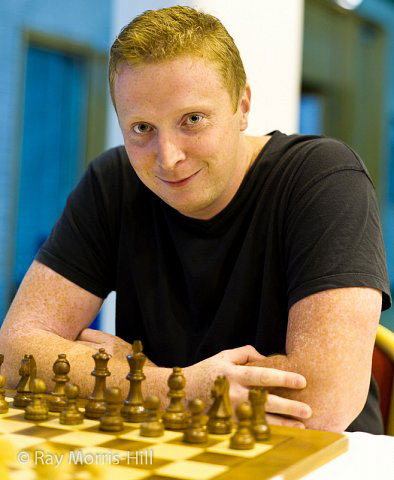
GM Simon Williams has been teaching, composing training DVDs and writing chess books for the last fifteen years. 'Play the Classical Dutch', his first chess book, was voted, in New in Chess, one of the top ten chess books of all time. For ChessBase he has made also the popular two-part DVD on the King’s Gambit, which together with the Amazing Moves reflects his own playing style, which is aggressive, favouring attacking chess to positional grinds.
Williams is very active as commentator at various chess events including Gibraltar, one of the strongest Opens in the world. Currently you can follow his commentary on the Anand-Carlsen match as a member of the ChessBase team.
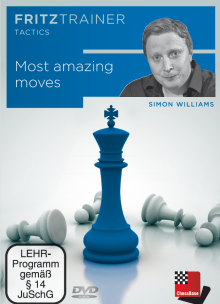 |
Simon Williams:
Most Amazing Moves
- Video running time: five hours 30 minutes
- With interactive training including video feedback
- Exclusive training database with 50 selected games
- Including CB 12 Reader
Price: €29.90
€25.13 without VAT (for Customers outside the EU)
$31.14 (without VAT)
ISBN: 978-3-86681-447-9
This DVD can be purchased as a hard copy or it can be downloaded directly from the Internet, that way sparing you the few days needed for it to arrive by post.
Order this Fritztrainer in the ChessBase Shop |
Sample Video: Simon Williams - Most amazing moves














